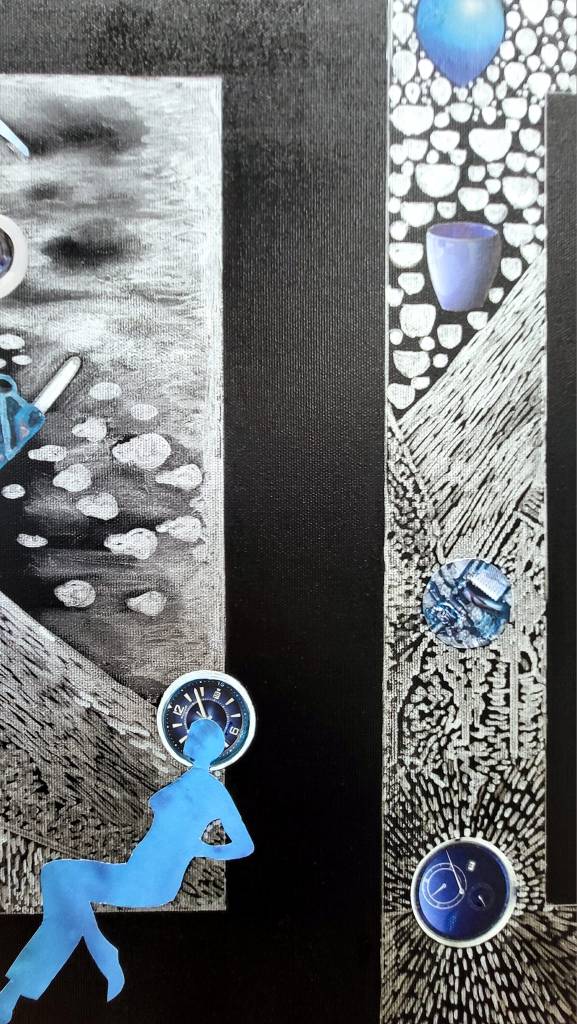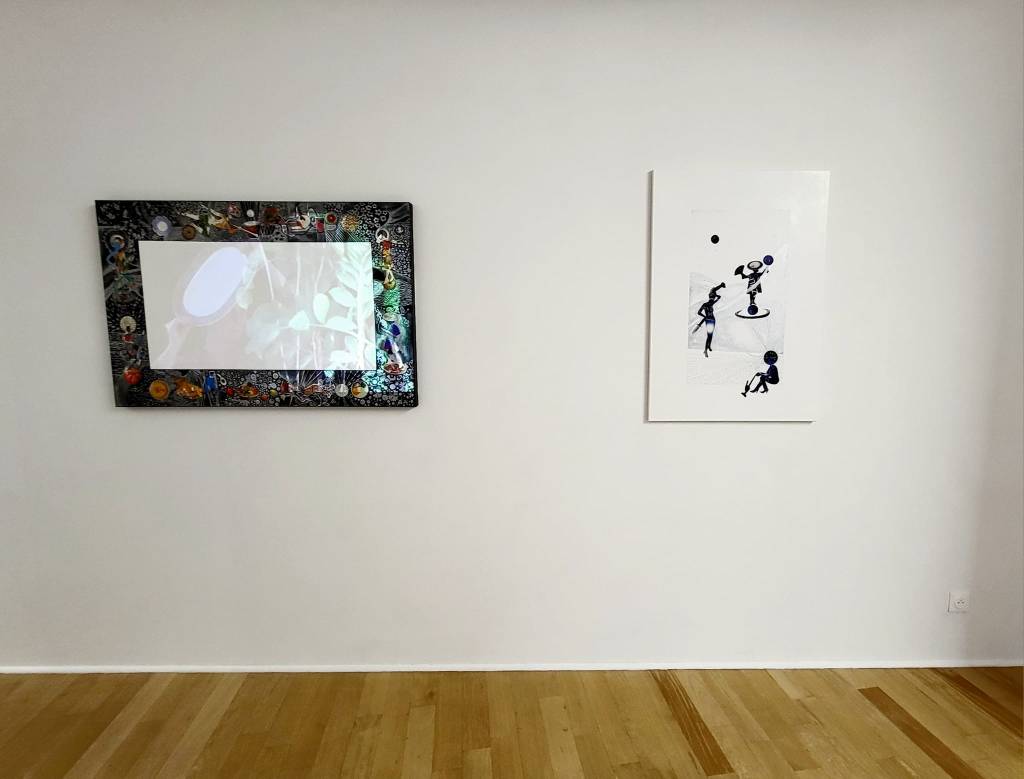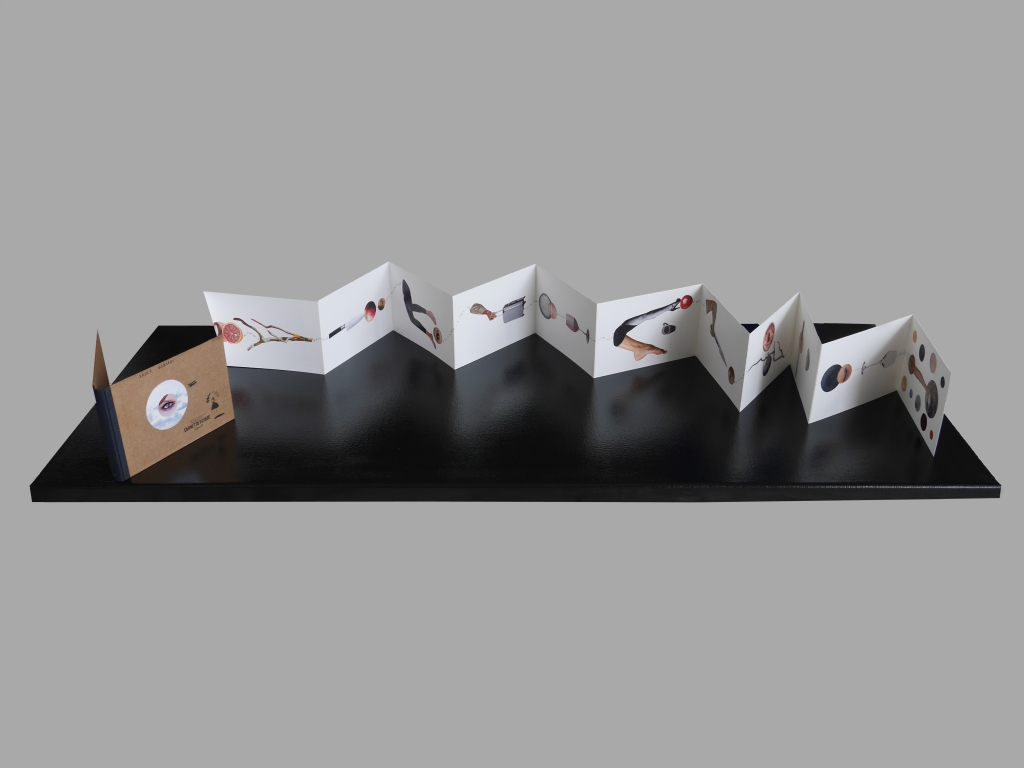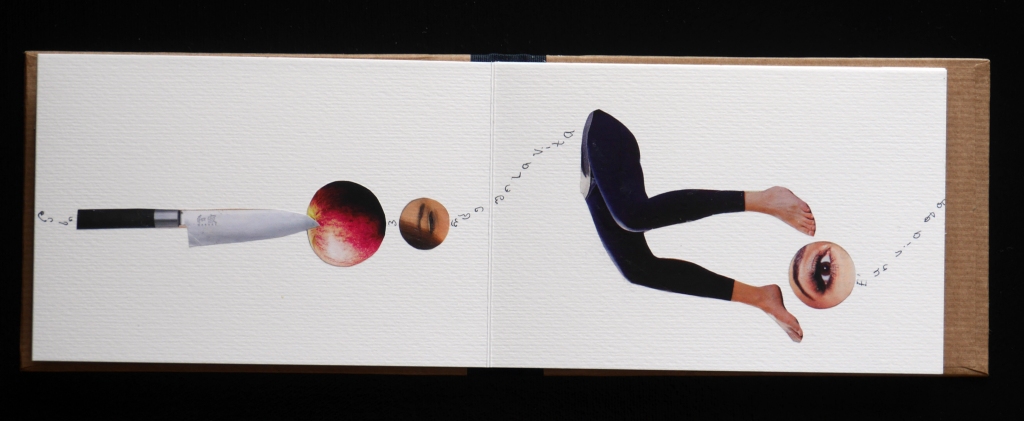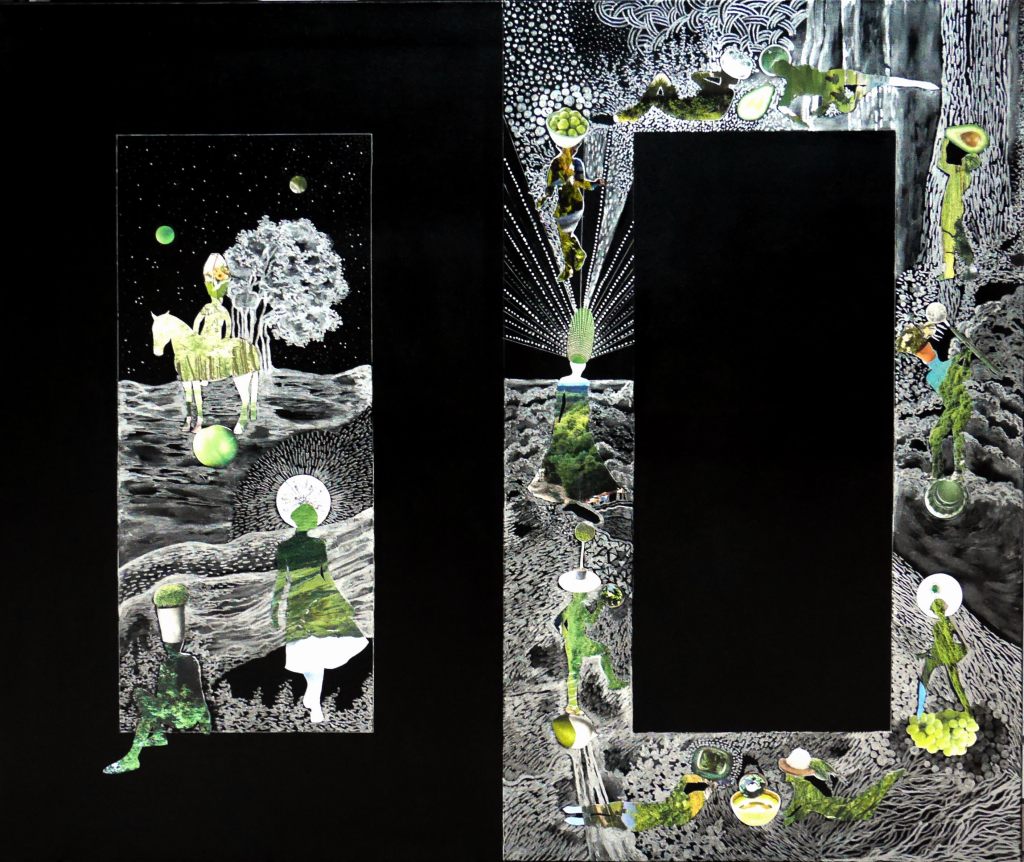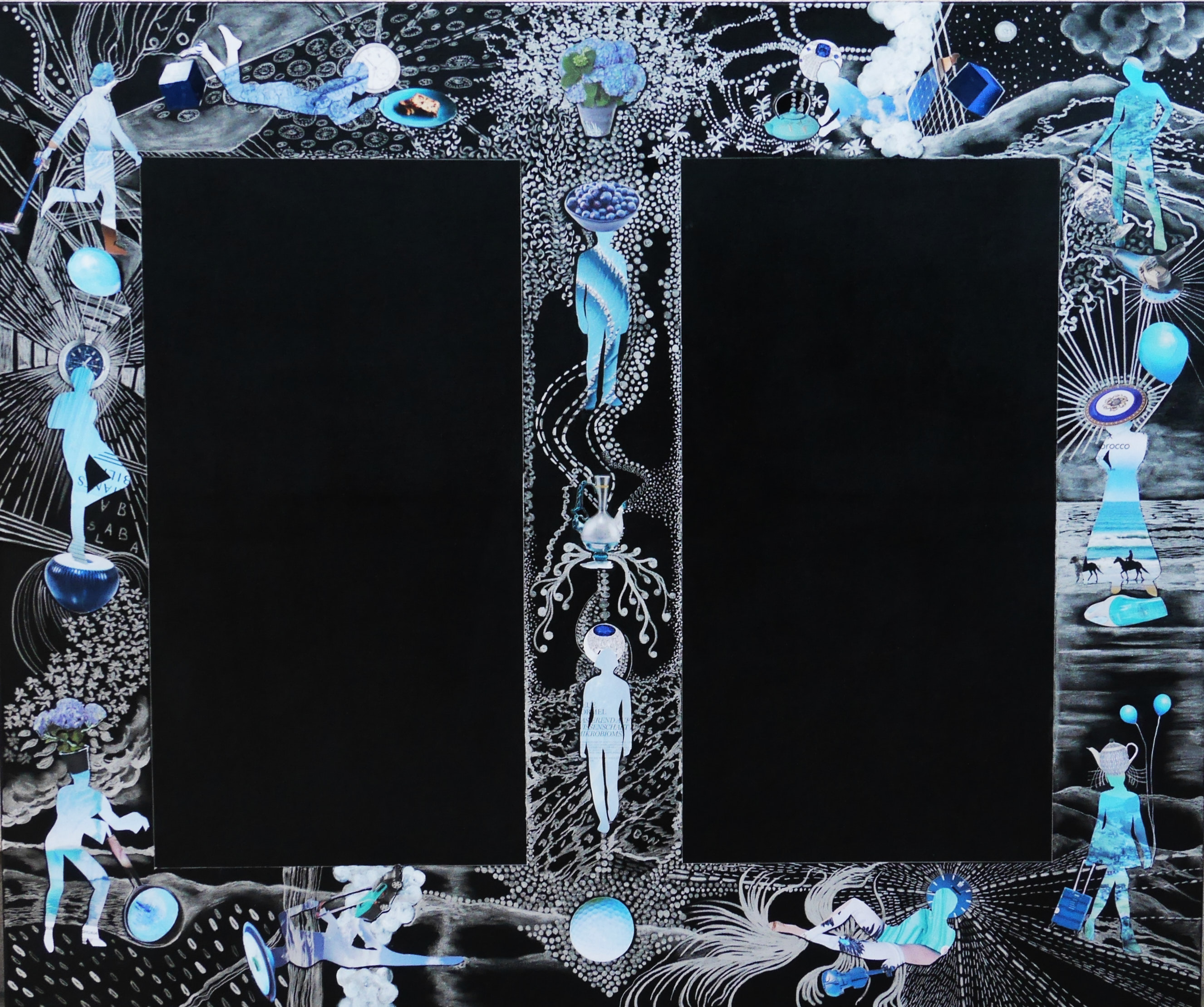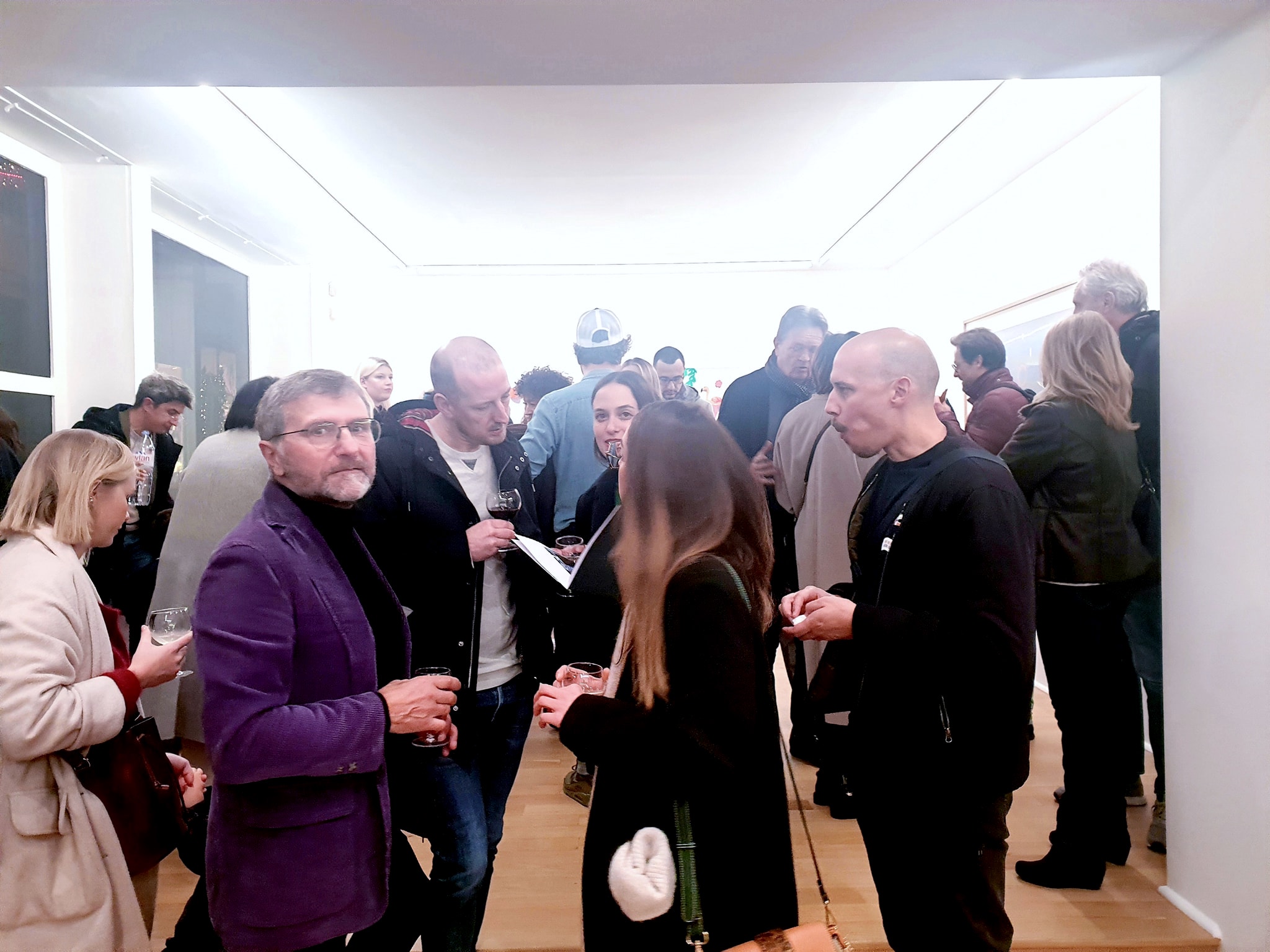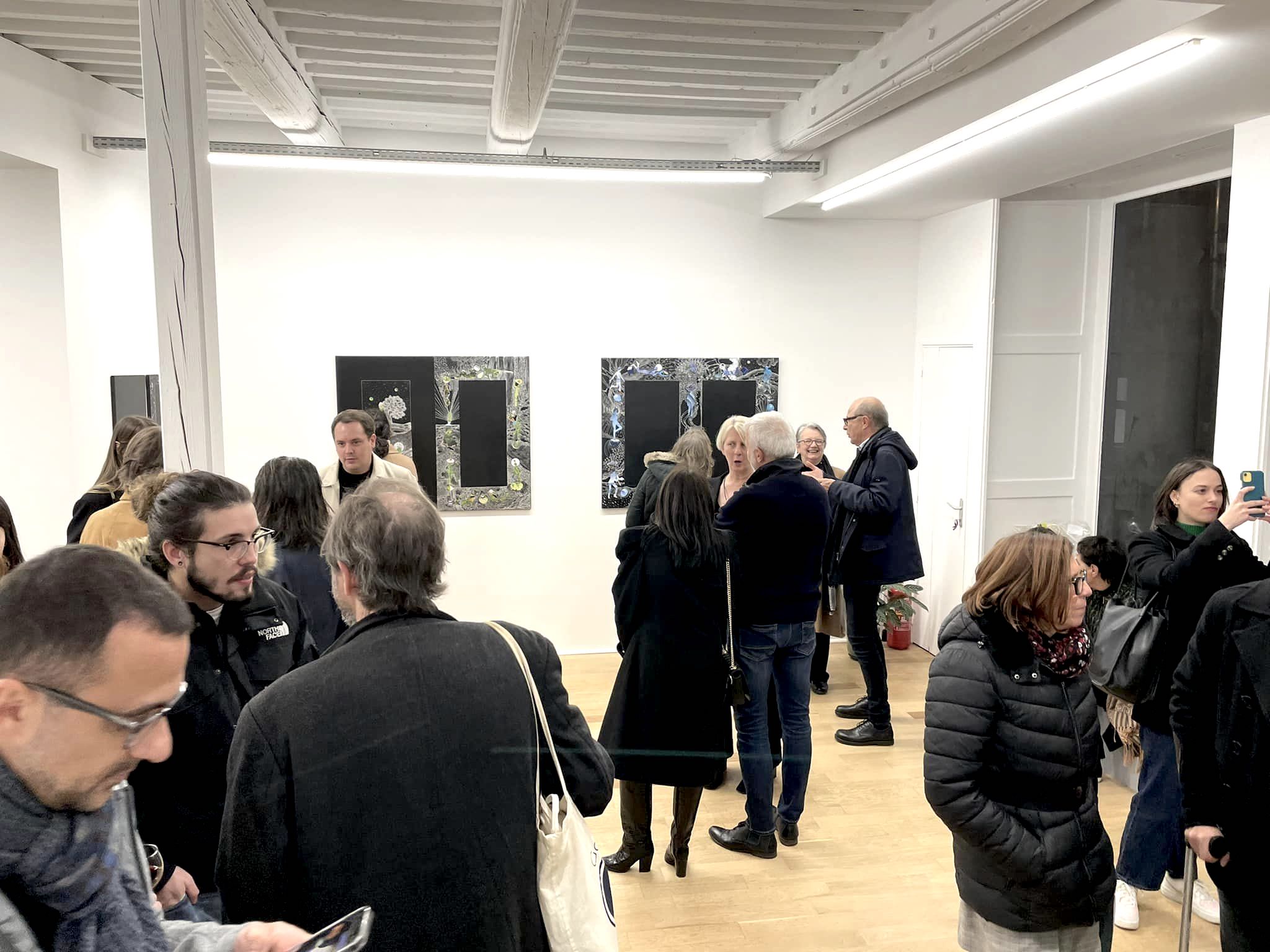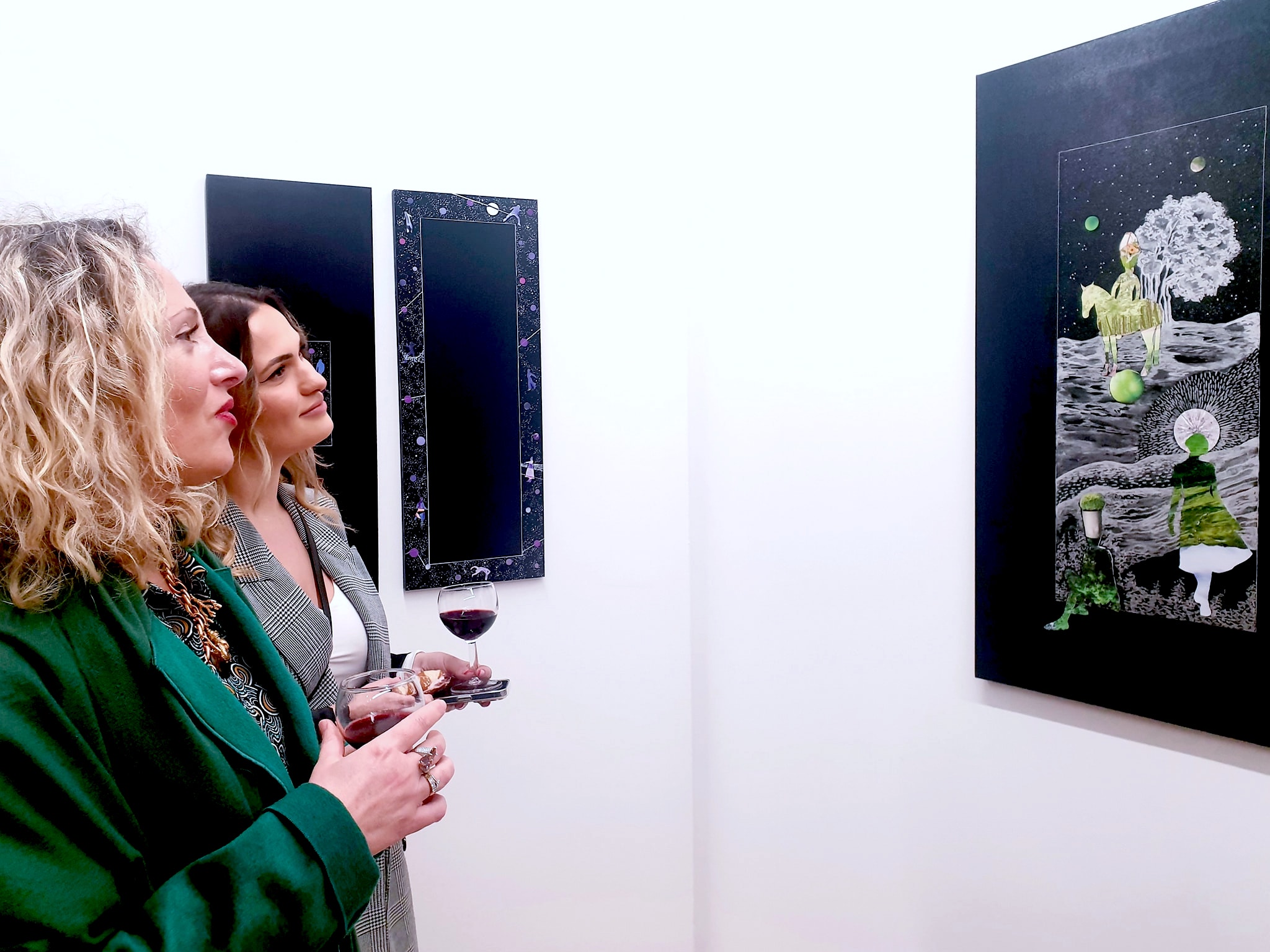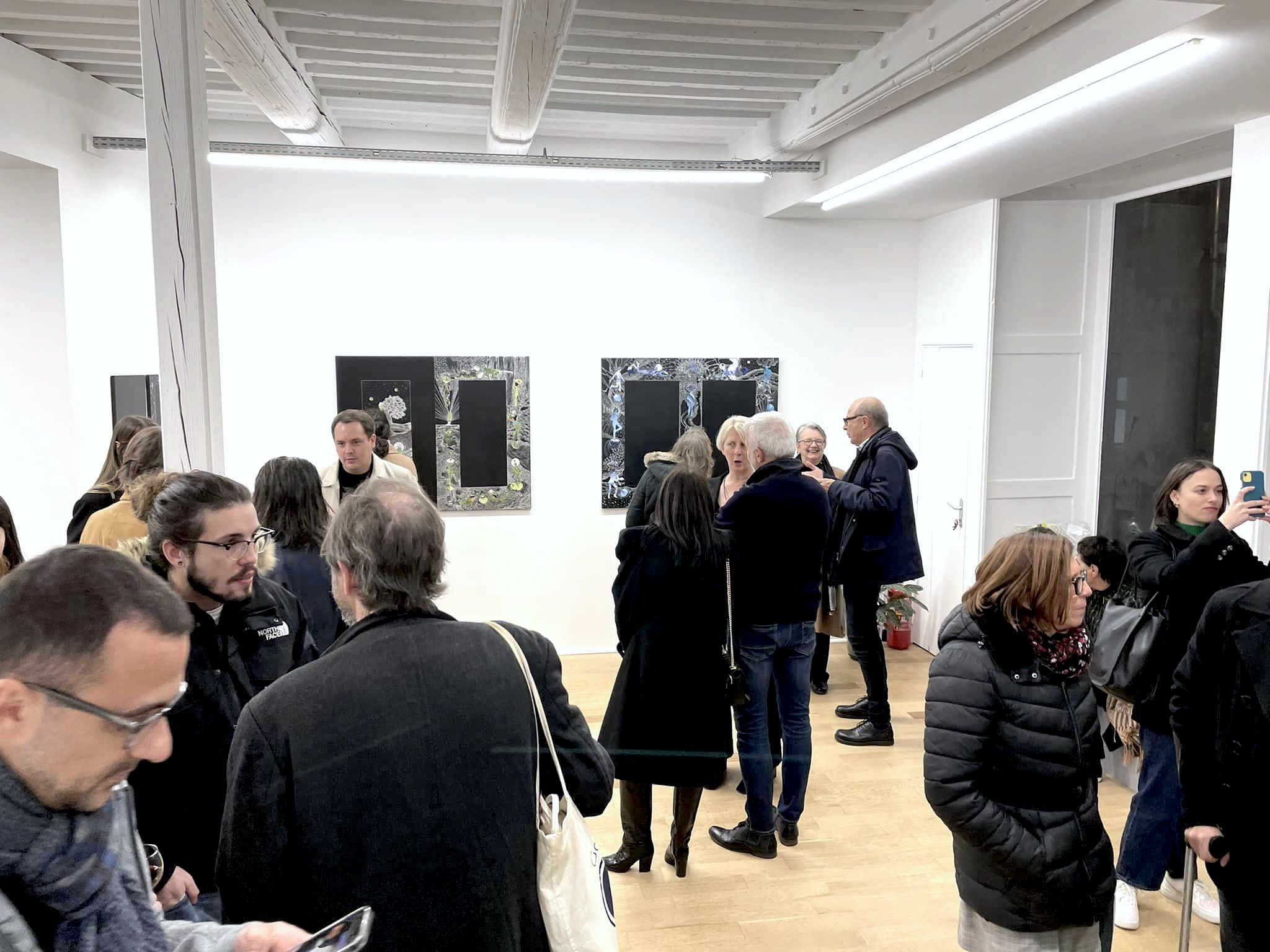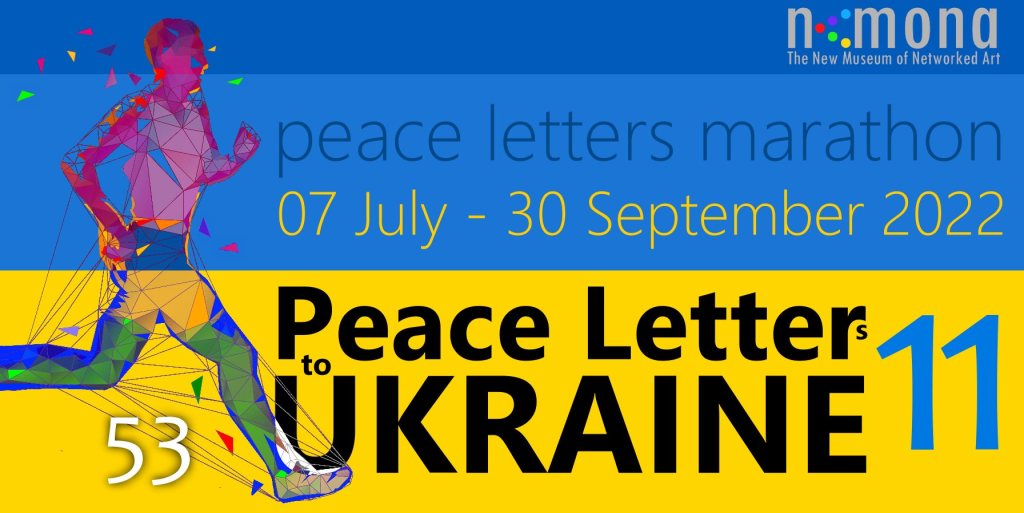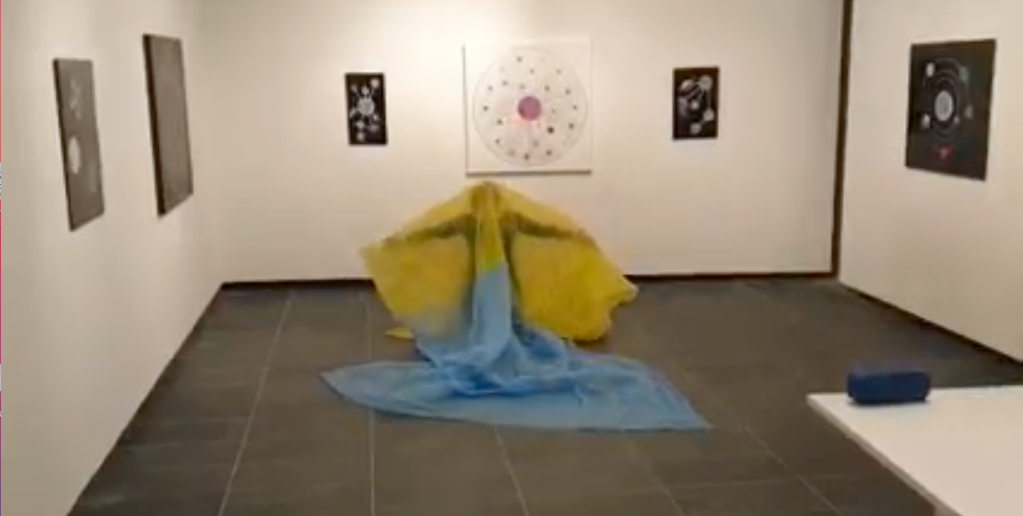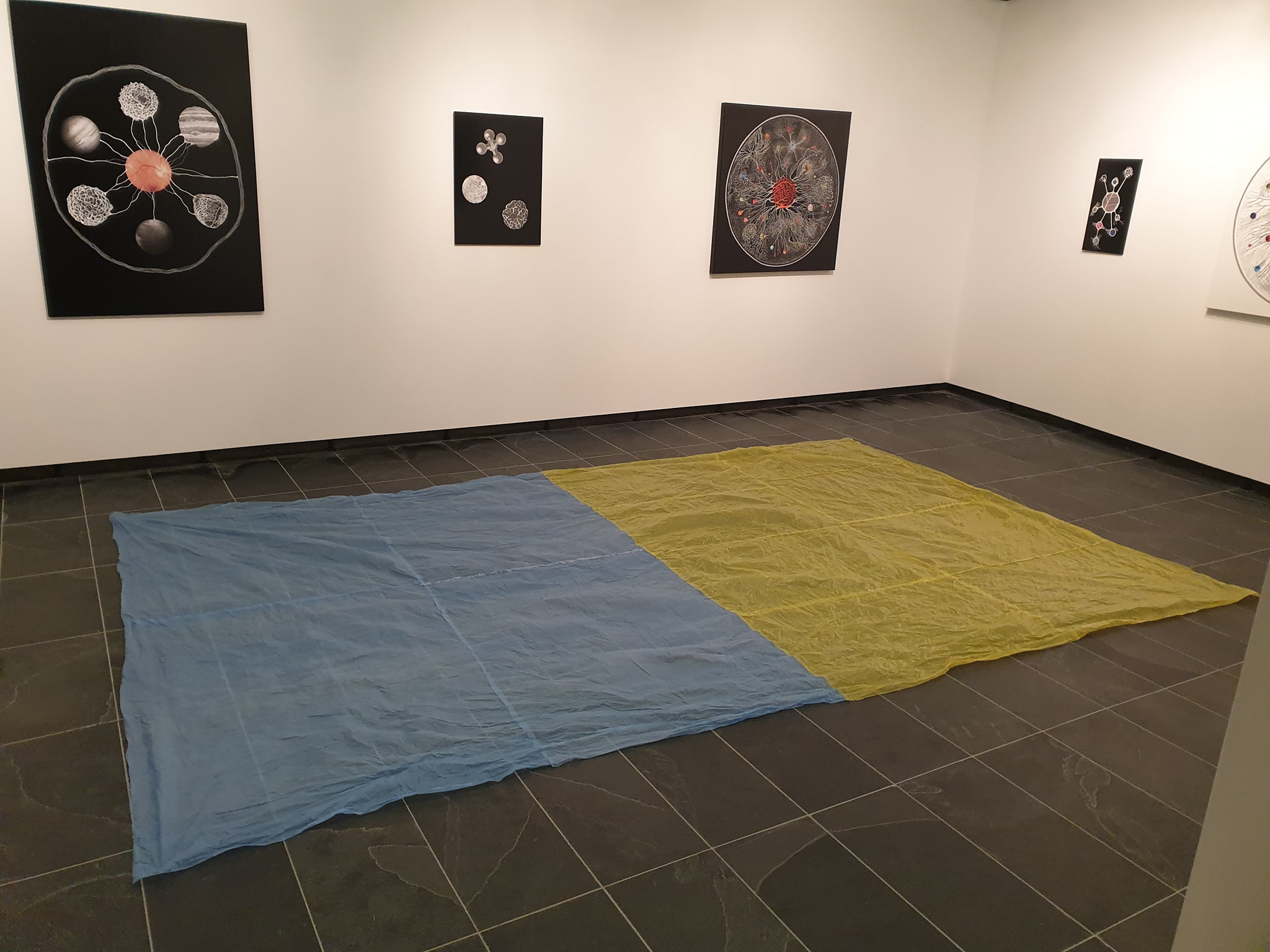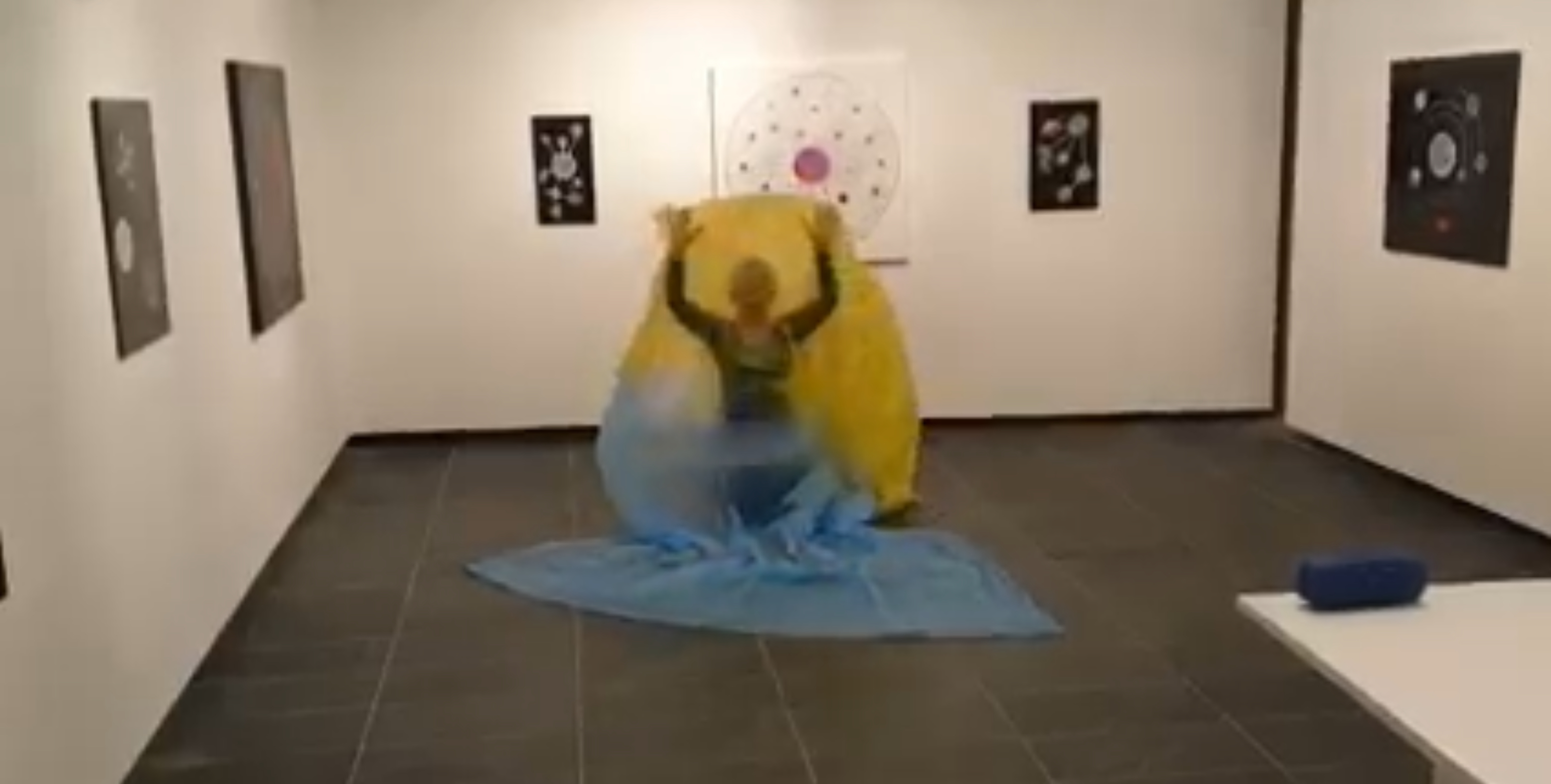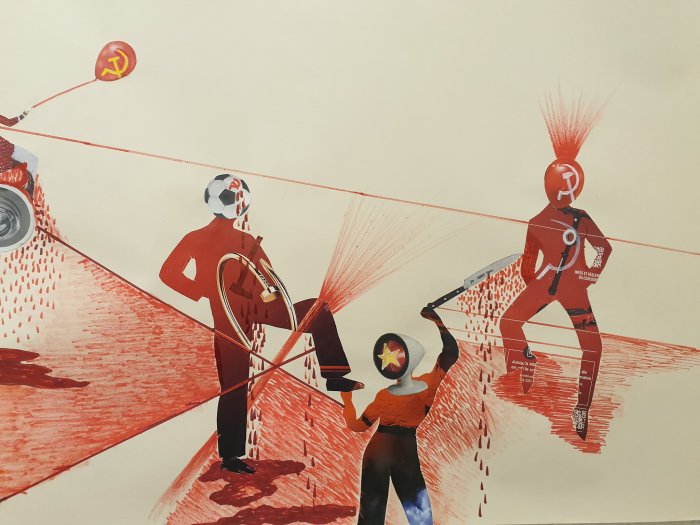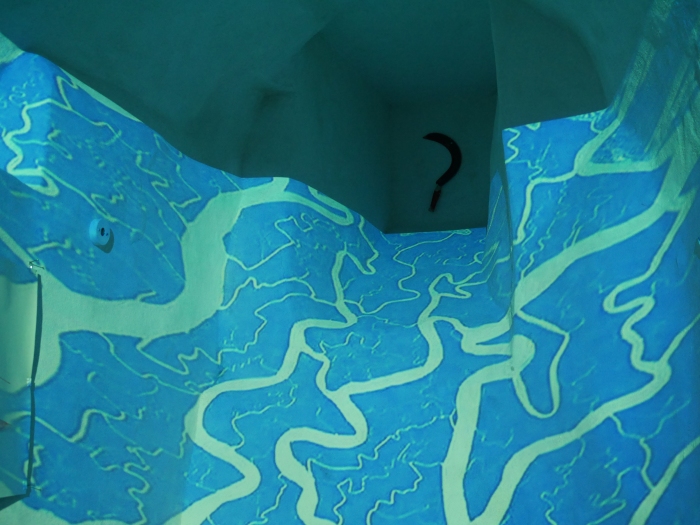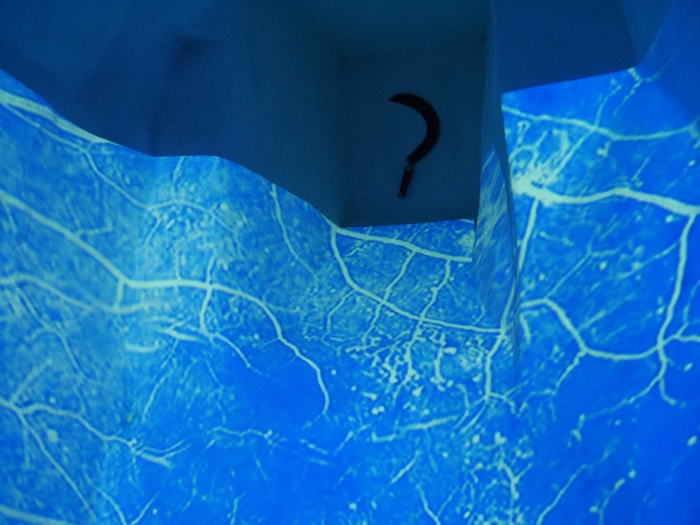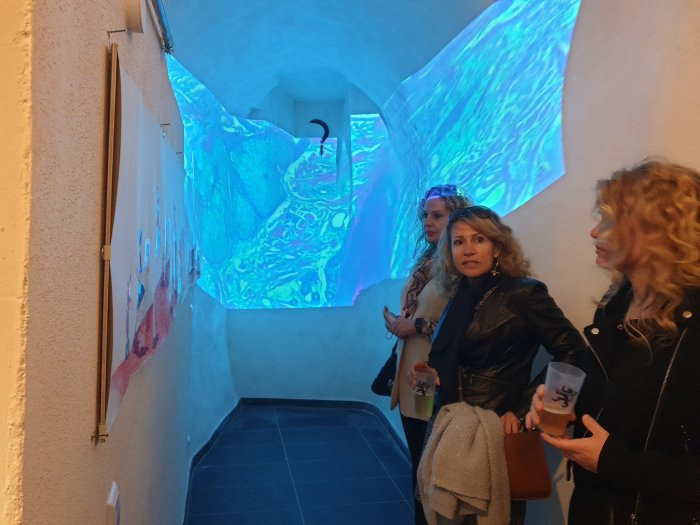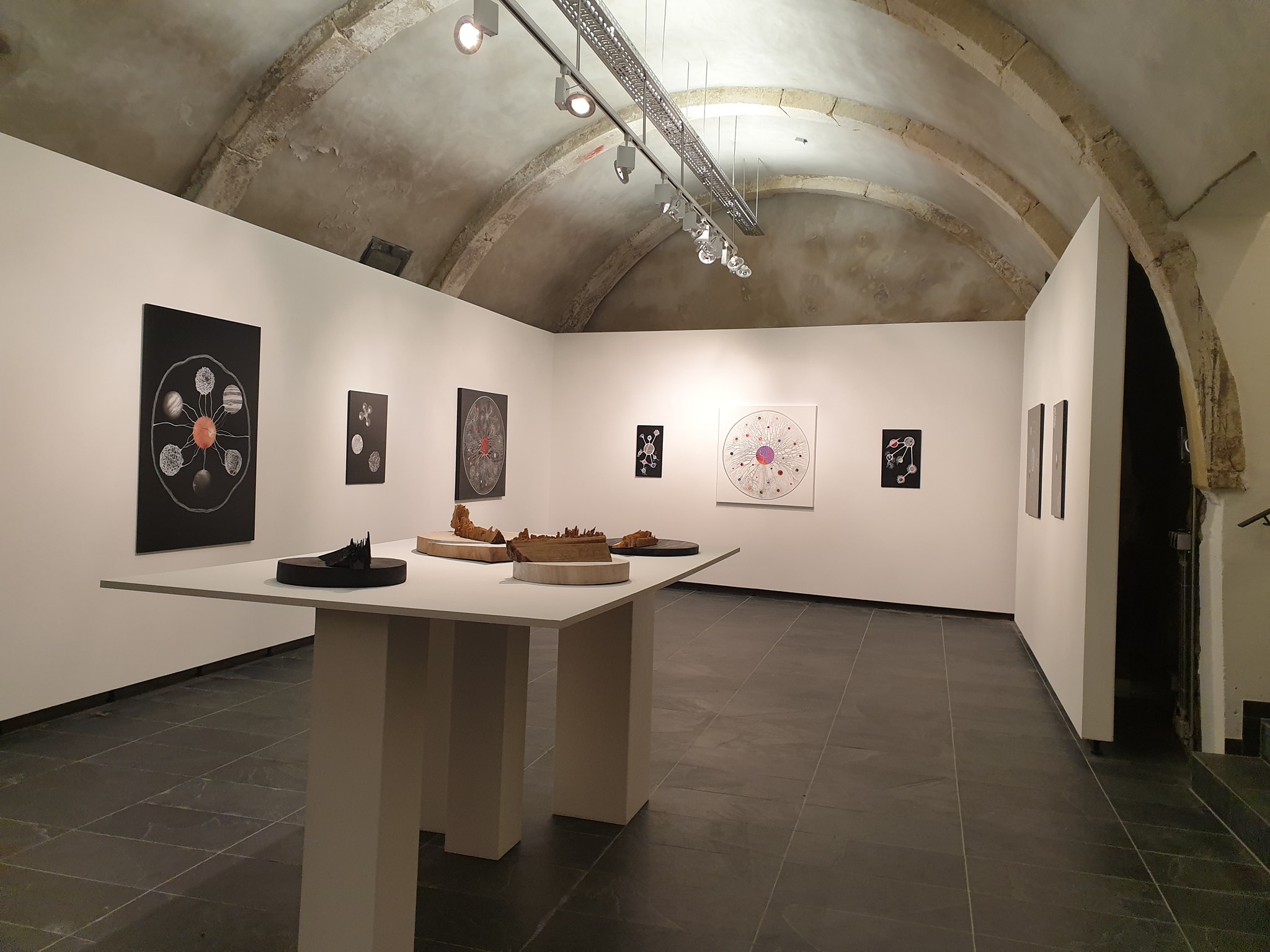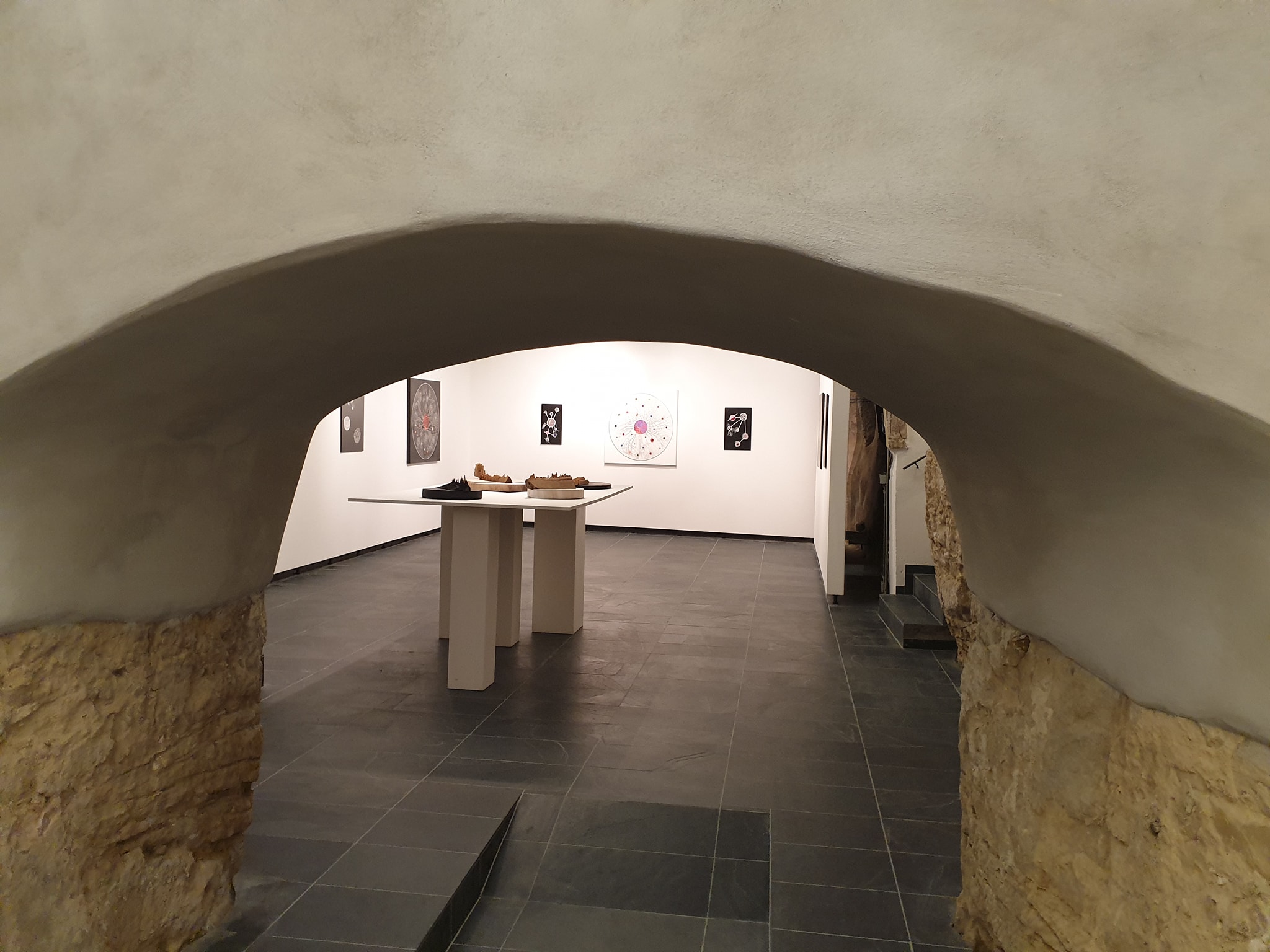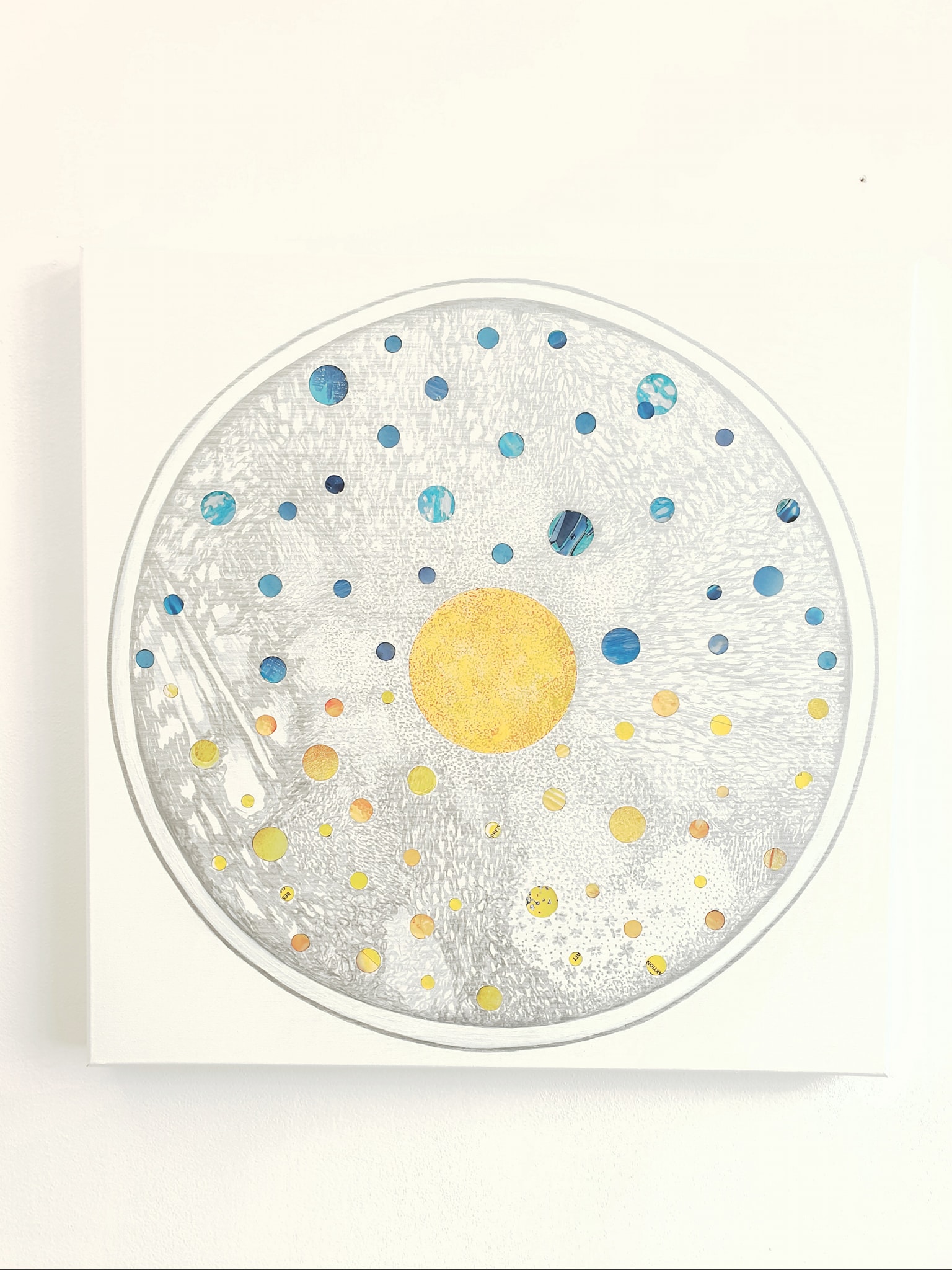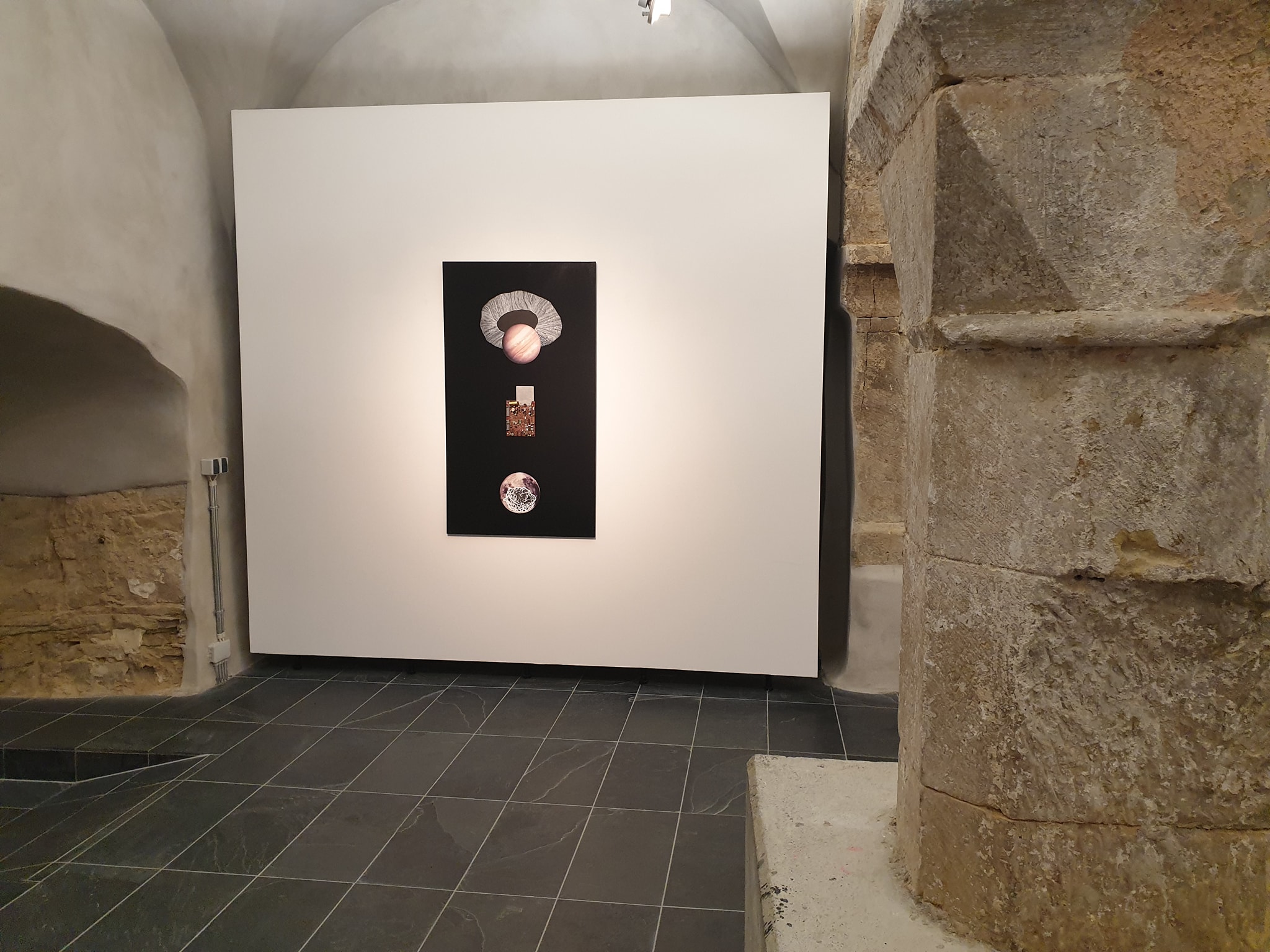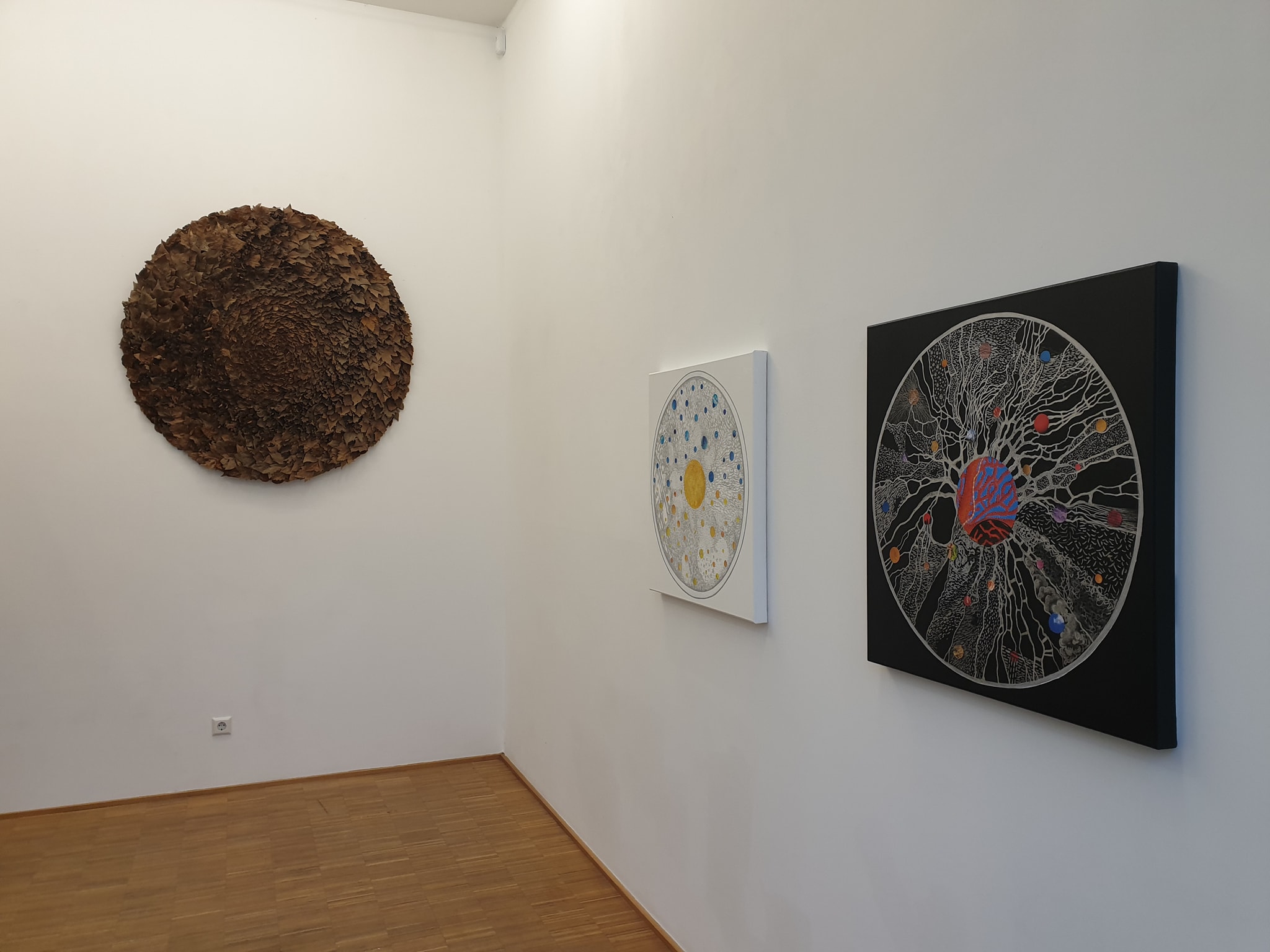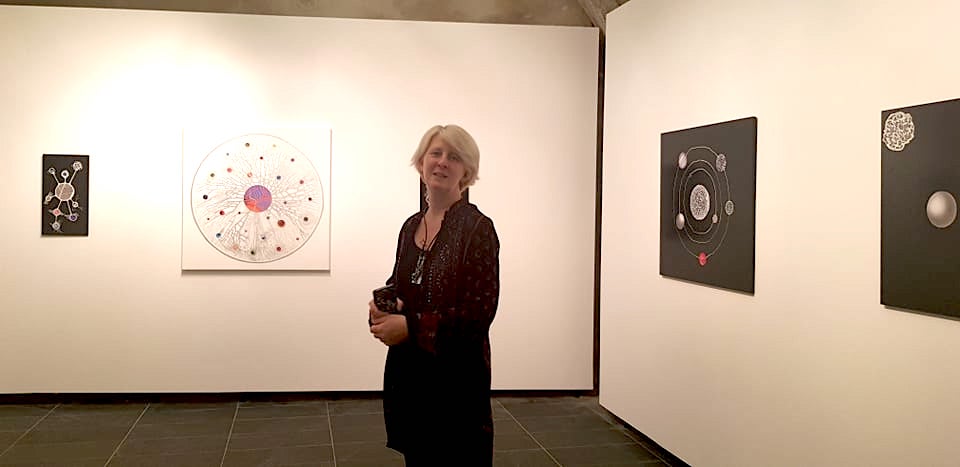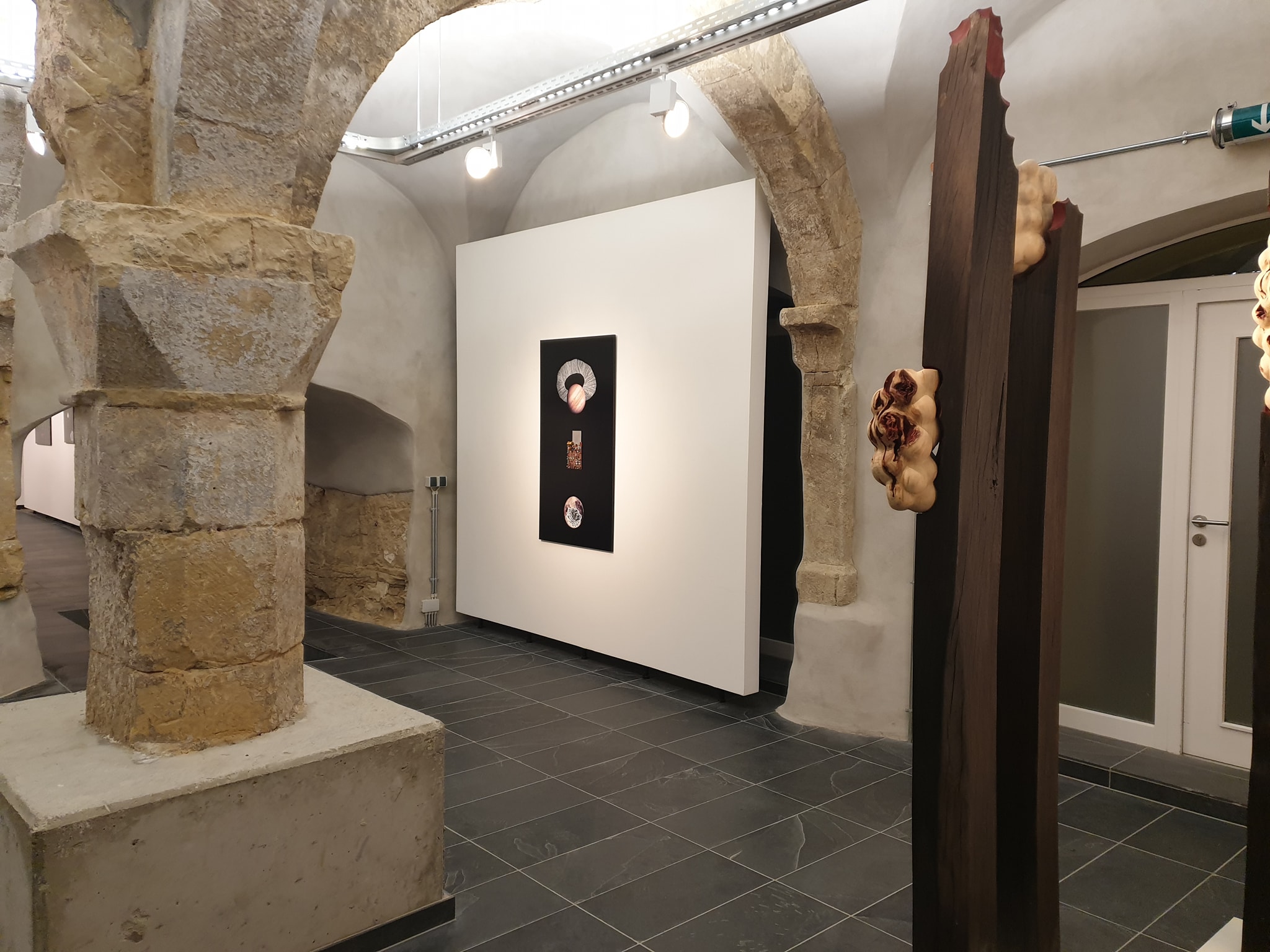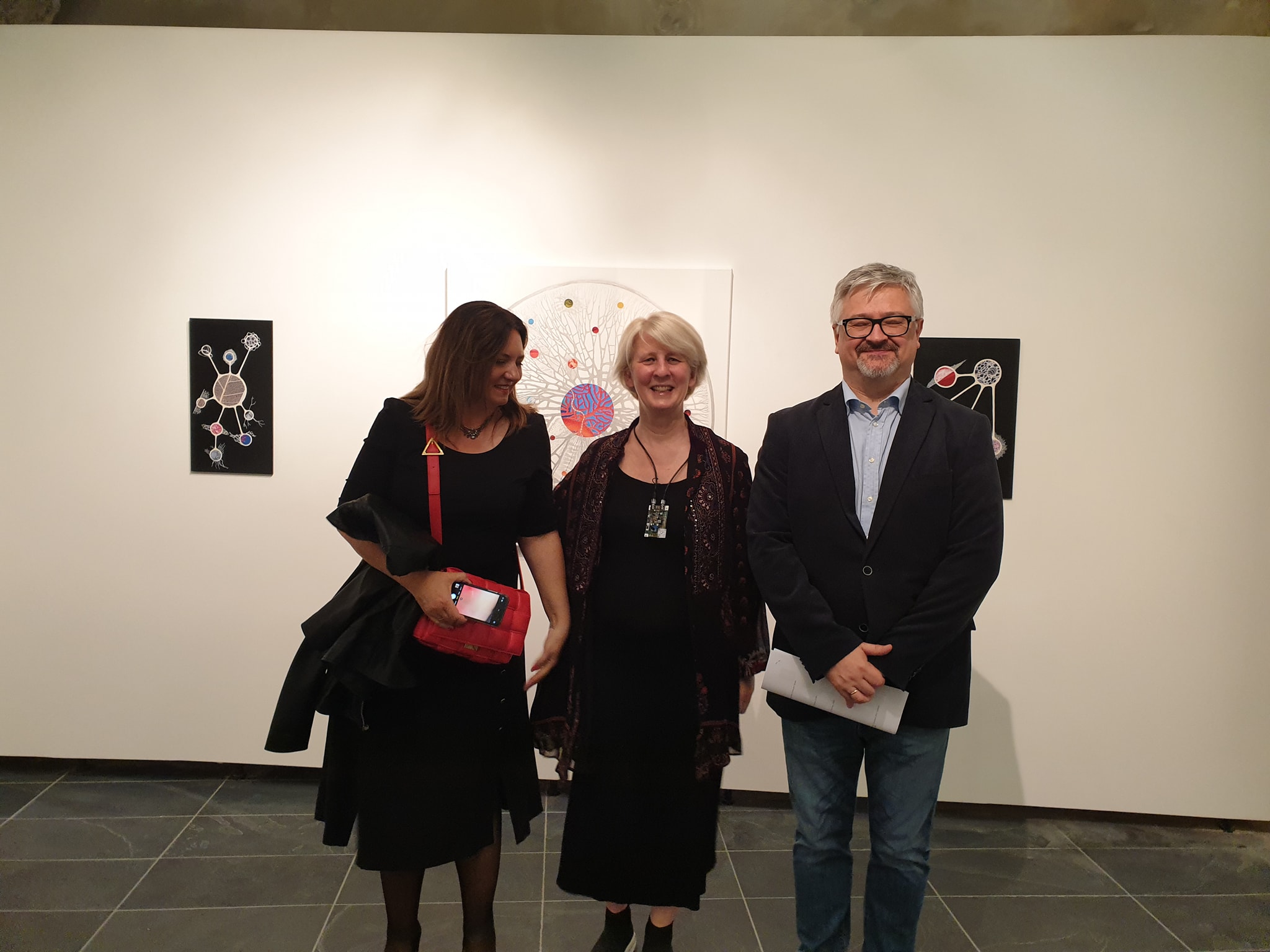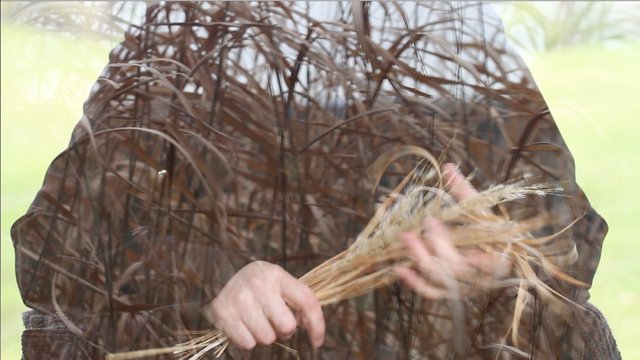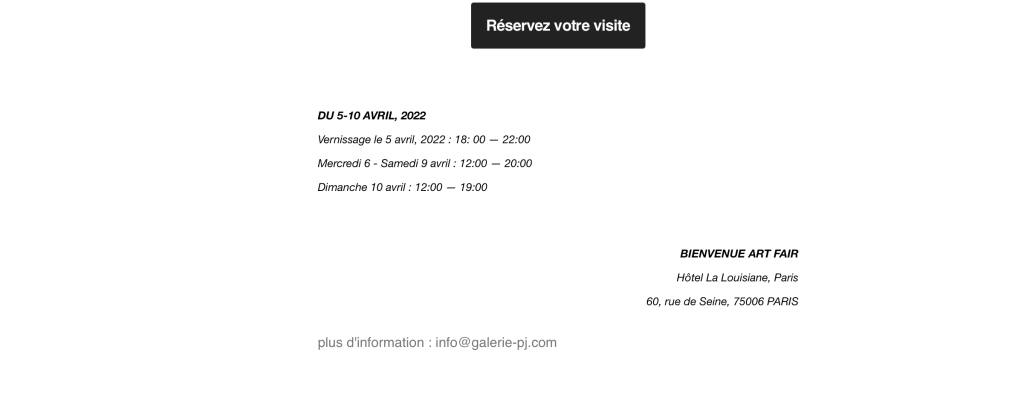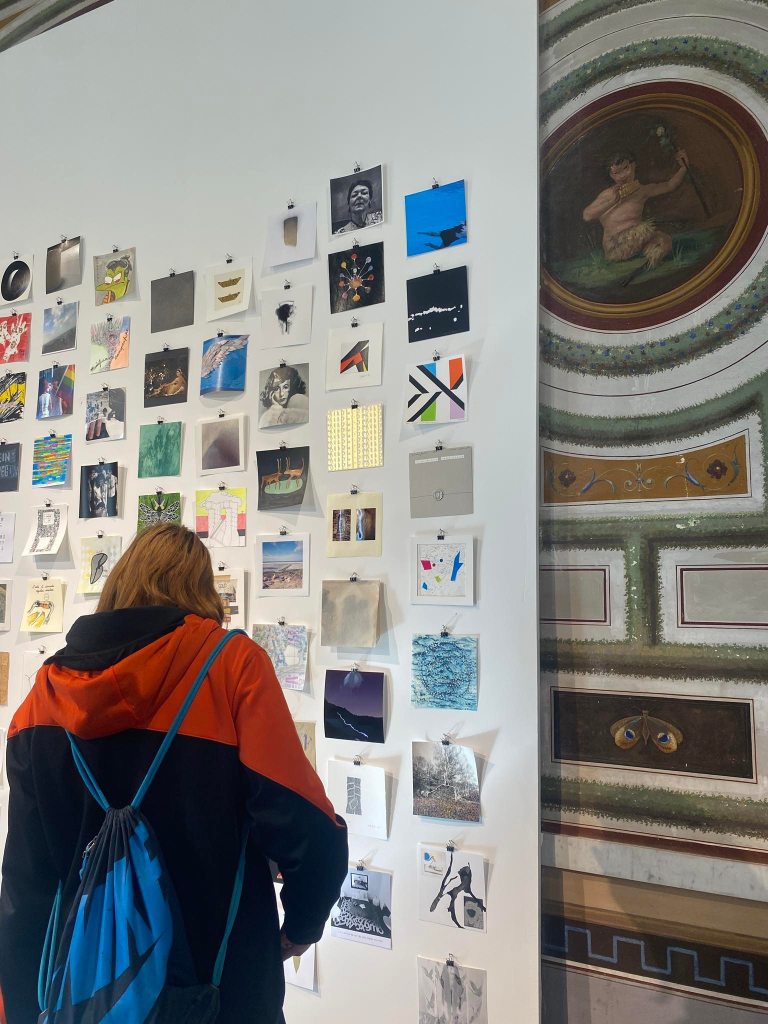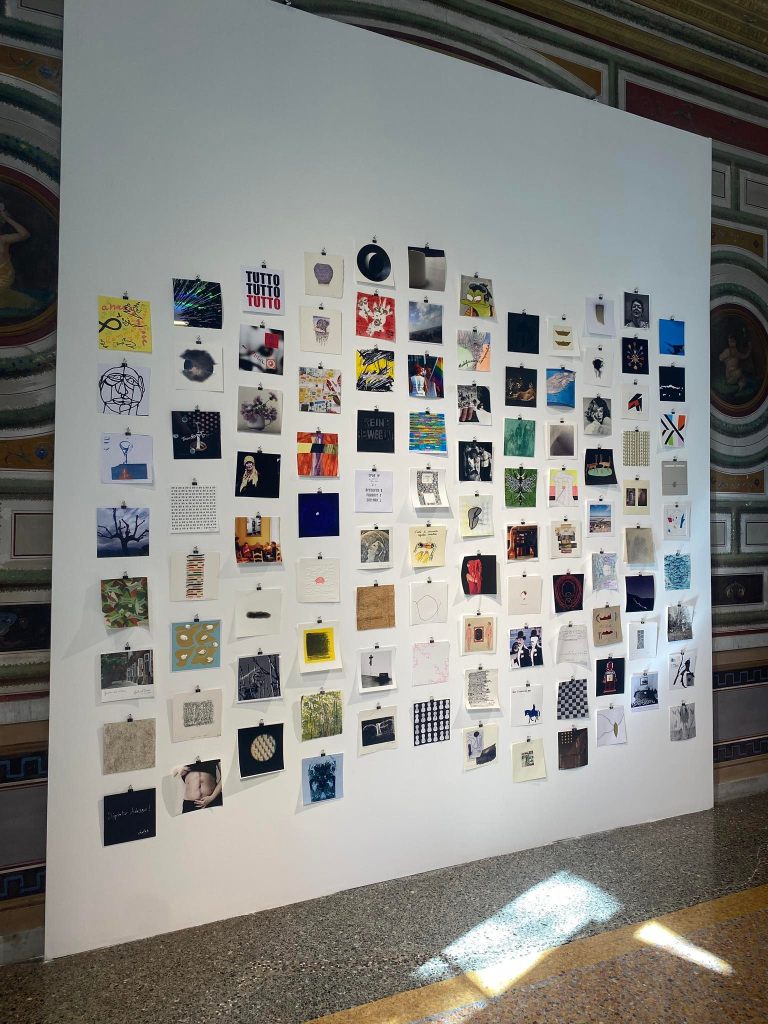
Irina Gabiani: “Minimal Complexity”
From 24 th of February to 30th of March
at
Galerie PJ
10, rue des Jardins, Metz, France
Irina Gabiani
Minimal Complexity
Les œuvres présentées relèvent du concept harmonique de « Minimal-Complexity », inventé par l’artiste Irina Gabiani, qui opere une fusion où minimalisme et complexité ne sont pas en opposition, mais se complètent mutuellement. L’art minimal, avec son essence de simplicité et son rejet de l’ornementation superflue, offre un contraste net avec des œuvres qui se réjouissent dans la richesse des détails et la complexité des compositions. Cependant, les œuvres d’Irina montrent comment ces deux approches peuvent coexister de manière harmonieuse et intrigante.
Chacune des œuvres dispose d’un motif de fond répétitif et détaillé, entremêlant peinture et papiers découpés, qui se combine harmonieusement avec un espace vide, monochrome.
Cet espace monochrome fonctionne comme une scène vide, un silence visuel qui attire l’attention non seulement sur ce qui est présenté, mais aussi sur ce qui est omis, en silence, oublié. Une toile de fond qui met en valeur la complexité environnante. Les motifs qui bordent cet espace inoccupé sont foisonnants et détaillés, invitant l’œil à se promener dans leurs complexités. Ces bordures ou espaces sont peuplés de figures, d’objets et de formes qui semblent à la fois aléatoires et soigneusement choisis, comme des acteurs dans une pièce où l’espace monochromatique sert de scène pour une performance qui n’a pas encore commencé ou qui vient juste de se terminer. Les couleurs vives – rose, bleu, vert, violet et jaune – enveloppent chaque œuvre, apportant une individualité distinctive. Chaque couleur provoque son propre ensemble d’émotions et d’associations. Les objets et les figures dans chaque tableau partagent la couleur dominante, créant une unité tout en ajoutant une complexité visuelle.
Enrichies par la texture et la dimension, les œuvres transcendent la toile pour inviter à une expérience tactile et visuelle plus riche. La peinture n’est que la toile de fond de ce théâtre d’ombres et de lumière, où les papiers découpés deviennent des acteurs dans un ballet de formes et de couleurs. Chaque découpe est une incision dans la réalité, un souffle d’existence qui défie la platitude de l’espace. Chacune s’élève, silhouette de papier, dans une danse délicate avec la gravité, ombres qui flottent sur la surface peinte comme les murmures d’un monde caché. Ce sont des fragments de rêves capturés, des instants figés qui semblent pouvoir se remettre en mouvement à tout instant sous le regard du spectateur. Ces papiers découpés ne sont pas de simples ajouts ; ils sont essentiels à la narration visuelle, des ponctuations dans le récit qui se déploie sur la toile. Ils ajoutent une profondeur littérale et figurative, établissant un dialogue entre le minimal et le complexe, le plat et le volumétrique, entre le sensible et l’imaginaire.
Dans le contexte de l’art « Minimal-Complexity », ces œuvres peuvent être vues comme une réflexion sur la nature de la perception et la manière dont nous attribuons de la signification aux espaces vides et pleins de notre environnement. L’espace monochrome de chaque œuvre pourrait représenter l’inconnu, l’indéfini, ou même le potentiel pur – un vide prêt à être rempli par l’expérience ou l’imagination. Les motifs périphériques détaillés représentent la réalité connue et inconnue, le monde tangible rempli d’éléments reconnaissables, présentés de manière inattendue. Ce jeu entre le vide et le détail, le simple et le complexe, engage une méditation sur la façon dont nous structurons et donnons un sens à l’espace autour de nous. Dans un monde surchargé d’informations et de stimuli, ces œuvres rappellent la puissance de la réduction, de la concentration et de la focalisation. Elles montrent comment un espace minimal peut être un terrain fertile pour une exploration complexe et comment le silence visuel peut parler aussi fort que l’abondance des formes et des couleurs. C’est là que le concept de « Minimal-Complexity » tisse son paradoxe, dans l’entrelacement des contraires – la simplicité austère et la complexité foisonnante.
Texte pour la vidéo :
Au cœur de l’exposition, une pièce maîtresse capte l’essence vibrante de la série « Minimal-Complexity » : une toile vivante où la peinture et le papier découpé rencontrent la dynamique de la vidéo. Cette œuvre, audacieuse fusion de médiums, est l’incarnation même de la complexité au sein de la simplicité.
La vidéo projetée présente l’artiste en méditation cinétique, jouant avec une assiette peinte – un microcosme du thème central de l’exposition. La blancheur de l’assiette, encerclée de noir et ornée de découpes et de peintures, devient un satellite en orbite autour de l’artiste, écho des mouvements célestes, une danse gravitationnelle autour de l’axe de son être.
Dans cette œuvre, la vidéo n’est pas une simple projection ; elle est intrinsèque à l’expérience de la toile, elle l’anime et la transforme. Le spectateur est convié à une interaction en temps réel, une dimension ajoutée où la performance projetée crée un dialogue perpétuel, un échange énergétique entre le créateur, le regardeur et la création.
Elle est un vibrant témoignage de l’évolution de la série Minimal-Complexe, un pont entre le tangible et l’éphémère, entre la permanence de la toile et l’effervescence de la performance.
Pierre Funes
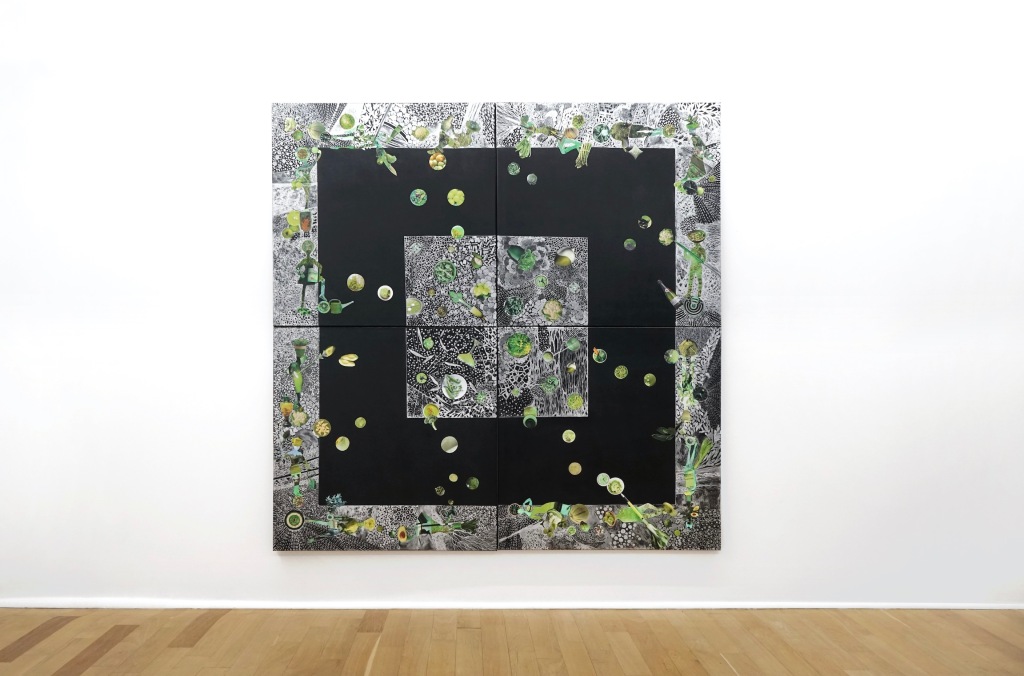
Minimi comuni denominatori
di Igor Zanti
Il termine “minimalismo” fu coniato nel 1965 dal filosofo inglese Richard Wollheim nell’articolo intitolato, appunto, Minimal Art, all’interno della rivista Arts Magazine. Egli parla di “riduzione minimale”, ma nel senso del contenuto artistico, relativamente a lavori dove entrano in gioco oggetti indistinguibili dalla realtà quotidiana, oppure forme ed immagini con valenze anonime e impersonali, citando da un lato i ready-made di Duchamp, che sono un punto di riferimento fondamentale per quello che riguarda la componente concettuale di ogni operazione riduzionista, e dall’altro Reinhardt, dal quale trae l’aspetto relativo alla riduzione purista della pittura e la sua concezione dell'”arte per l’arte”, tesa all’eliminazione di tutto ciò che viene percepito come non essenziale.
Senza ombra di dubbio la definizione del concetto di minimalismo non è andata a influenzare solo gli ambiti delle arti visive ma ha coinvolto tutto il mondo della creatività, dall’architettura alla moda, dal design al teatro.
Le pratiche artistiche di sapore tardo minimalistico e concettuale, sono tutt’ora presenti nel mondo dell’arte contemporanea, sebbene siano passati quasi settant’anni dalla loro nascita e diffusione.
Non è affatto raro girando per mostre, fiere, biennali, trovare opere di artisti che in maniera più o meno diretta si rifanno a questo tipo di pratica artistica.
Sorprende però che l’artista di origine georgiane Irina Gabiani che da anni conduce una ricerca complessa dove prevale un raffinato e prezioso grafismo integrato, talvolta, con l’utilizzo di altri media oltre il disegno e la pittura, si interroghi sulla “complessità del minimalismo”.
Innanzitutto vi è già nel titolo che raccoglie questo corpus di opere una stranezza o una curiosità. Se il minimalismo come sosteneva Wollheim è una azione di riduzione minimale, dovrebbe implicitamente escludere la complessità, quasi vi sia un rapporto ossimorico tra il concetto di minimale e il concetto di complesso.
Irina Gabiani aggira e rielabora questo scoglio teorico cogliendo il processo di minimizzazione, cristallizzando la riduzione in minimi termini dell’opera attraverso due espedienti visivi e concettuali: la geometria e la mancanza, il vuoto, la sottrazione.
Le opere in mostra infatti pur mantenendo e definendo lo spazio attraverso quelle che potremmo definire semplicemente cornici, per quanto sia più appropriato utilizzare il termine confini, che presentano la firma stilistica della Gabiani, con un minuto grafismo in cui s’intrecciano oggetti antropomorfi, contengono il vuoto, un vuoto che è simbolo di privazione, un vuoto che pare disciplinato solo dalla forma geometrica del confine, la geometria come forza regolatrice e dominante. La sottrazione per la creazione del vuoto si ripropone però in tele che sono solo apparentemente complementari e compensatorie, ma che rappresentano invece un emergere dal vuoto come uno scoglio che emerge dal mare.
In questo caso il minimalismo acquista una complessità altra perché è colto nella sua forma più estrema: dalla semplificazione alla geometria, dalla geometria al vuoto, alla dissoluzione, allo sprofondare in un universo altro.
Proprio in questo tema dell’universo, della dimensione spirituale, ritroviamo uno dei topos del lavoro di Irina Gabiani che ha sempre introdotto una dimensione di forte spiritualità di sapore quasi sciamanico nella sua ricerca utilizzando simbolismi arcani, forme apotropaiche e rimandi antropomorfi, sapore antico quasi primitivo.
Irina Gabiani fa un passo avanti nella sua ricerca, evolve il suo lavoro stravolgendo alcune certezze consolidate applicando le pratica del pensiero laterale e facendoci scoprire come il minimalismo nasconda nel suo processo creativo mille complessità svelandoci una nuova dimensione della sua complessa ricerca artistica.
Lowest common denominators
By Igor Zanti
The term “minimalism” was created in 1965 by the English philosopher Richard Wollheim in the article entitled Minimal Art, within an issue of Arts Magazine. He writes of “minimal reduction”, but in the sense of artistic content, in relation to works where objects indistinguishable from everyday reality come into play, or forms and images with anonymous and impersonal values, citing on the one hand Duchamp’s ready-mades, which are a fundamental point of reference for what concerns the conceptual component of every reductionist operation, and on the other hand Reinhardt, from whom he draws the aspect relating to the purist reduction of painting and his conception of “art for art’s sake”, aimed at eliminating everything that is perceived as non-essential.
Without a shadow of a doubt, the definition of the concept of minimalism has not only influenced the fields of visual arts but has involved the entire world of creativity, from architecture to fashion, from design to theatre.
Artistic practices with a late minimalist and conceptual flavor are still present in the world of contemporary art, although almost seventy years have passed since their birth and diffusion. It is not at all uncommon when wandering around exhibitions, fairs, biennials, to find works by artists who, in a more or less direct way, refer to this type of artistic practice.
However, it is surprising that the Georgian-born artist Irina Gabiani, who for years has been conducting complex research where a refined and precious integrated graphic design prevails, sometimes, with the use of other media besides drawing and painting, questions herself about the “complexity of minimalism ”.
First of all, there is already a strangeness or curiosity in the title that collects this corpus of works. If minimalism, as Wollheim argued, is an action of minimal reduction, it should implicitly exclude complexity, almost as if there is an oxymoronic relationship between the concept of minimal and the concept of complex.
Irina Gabiani circumvents and reworks this theoretical obstacle by grasping the process of minimization, crystallizing the reduction of the work to minimum terms through two visual and conceptual expedients: geometry and absence, emptiness, subtraction.
In fact, the works on display, while maintaining and defining the space through what we could simply define as frames, although it is more appropriate to use the term borders, which present Gabiani’s stylistic signature, with a minute graphism in which anthropomorphic objects are intertwined, contain the void, a void that is a symbol of deprivation, a void that seems to be disciplined only by the geometric shape of the border, geometry as a regulating and dominant force. The subtraction for the creation of the void, however, is repeated in canvases which are only apparently complementary and compensatory, but which instead represent an emergence from the void like a rock emerging from the sea.
In this case minimalism acquires a different complexity because it is captured in its most extreme form: from simplification to geometry, from geometry to emptiness, to dissolution, to the sinking into another universe.
Precisely in this theme of the universe, of the spiritual dimension, we find one of the topos of Irina Gabiani’s work who has always introduced a dimension of strong spirituality with an almost shamanic flavor in her research using arcane symbolism, apotropaic forms and anthropomorphic references, an almost ancient flavor primitive.
Irina Gabiani takes a step forward in her research, evolves her work by overturning some consolidated certainties by applying the practice of lateral thinking and making us discover how minimalism hides a thousand complexities in its creative process, revealing a new dimension of her complex artistic research.

Irina Gabiani new series of works:
“Minimal-Complexity”
“Minimal-Complexity” is the title of the new series of works by Irina Gabiani, through which the Artist reinterprets the language of Minimalism.
Gabiani unveils the complexity hidden in the apparently solid structures, geometric shapes and lines, in light of her view of the Universe, where everything and everyone is interrelated, interconnected, and where every behavior is, therefore, consequentially connected.
Reminding the viewers of such ontological characteristics of the Universe and of the consequent individual responsibility, which derives from them, is key to Gabiani’s Art.
Gabiani’s signature evolving pattern, which consists in the continuous transformation through drawings of an image into another one, is used to show the endless and continuous transformation that everything and everyone undergoes and the deeply intertwined reality we are part of.
The collage itself, which is one of the techniques used by the Artist in her works, is specifically chosen for its power to reconduct everything to unity. The images chosen by the Artist are dictating the transformation path.
The complexity unveiled by Gabiani in the minimal structures often challenges the rules of the game and the rigid frames in which it is hosted.”
Ivan. M. Adorno













